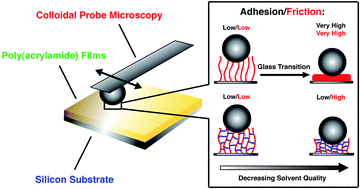Adhesive and nanotribological properties of end-grafted poly(acrylamide) (PAAm) films with various degrees of crosslinking, and in the presence of solvents over a broad spectrum of quality, were investigated by means of colloidal-probe atomic force microscopy. The solvent consisted of a mixture of water (good solvent for PAAm) and methanol (bad solvent for PAAm). Adhesion measurements carried out on brush (uncrosslinked) structures revealed significant pull-off forces in solvent mixtures that placed the polymer at its glass transition. These pull-off forces, which were orders of magnitude higher than those measured in either pure solvent, were significantly reduced in the presence of crosslinking. The nanostructures of PAAm films with different crosslinking degrees were elucidated in their maximum collapsed state by means of atomic force microscopy, and the parameters influencing adhesive properties of films with brush structures at their glass transition were investigated. Complex nanotribological behavior of PAAm films was observed, and found to result from the interplay of film structure and adhesion forces, which were influenced by both crosslinking degree and solvent quality.

You have access to this article
 Please wait while we load your content...
Something went wrong. Try again?
Please wait while we load your content...
Something went wrong. Try again?


 Please wait while we load your content...
Please wait while we load your content...